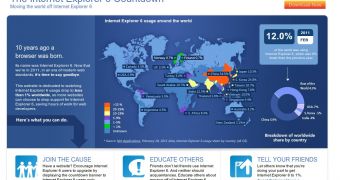Ten years after it came into service, Internet Explorer 6 is still used by a lot more people than it should at this point. There have been several efforts to determine those still using it to upgrade and now even Microsoft is joining the 'fight.'
The giant has launched ie6countdown.com which aims to track usage of the aging browser around the world until global usage goes below one percent. Considering that it's still at 12 percent, that may be a while.
There's hardly a browser more hated by web developers, but even as it's now a decade old, it's still used by a large number of people, especially in some parts of the world and in corporate environments.
But it's awfully out of date, non standard compliant and generally a pain for web developers trying to make their sites work for everyone.
Microsoft is also providing those interested with a piece of code that notifies IE6 users that there are better or at least newer alternatives. The code also provides a link to upgrade their browser, obviously to a newer version of Internet Explorer.
Unfortunately, since those running IE6 are also running Windows XP, the newest Internet Explorer they can get is IE8, which is already a couple of years old and has no support for thew newer web technologies, HTML5 and friends, so they're better off with alternative such as Mozilla Firefox or Google Chrome.
More interesting though, the new site also provides a map of usage around the world. And, while the overall figure is at 12 percent, things are better than they may seem.
All the data is already public, but having it aggregated and displayed provides a better overview. In much of the developed world, usage is well below five percent.
In the US, just 2.9 percent of users are still running IE6 the same figure as in Germany. It gets better, in Norway and Finland just 0.7 percent of internet users browse with IE6.
In Asia, though, things aren't looking so good. In China, a huge 34.5 percent of users are running IE6. Since China has the world's largest usage base, it drags the global average up to 12 percent.

 14 DAY TRIAL //
14 DAY TRIAL //